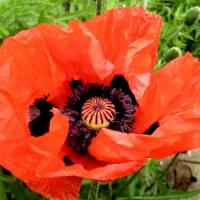Episode 26: Gardening Jobs & Plants of Interest for May

Download: Episode 26: Gardening Jobs & Plants of Interest for May
File Size: 12.9 MB, Duration: 27' 48"
May is probably one of the best months in the garden. While all of the seasons in the garden have something to offer, late spring has to be one of the better ones.
The weather is not too hot and there is usually sufficient rainfall, the perfect combination for optimum growing conditions. But with perfect growing conditions comes lots of hard work. There is definitely lots to do for the keen gardener this month, and the weeds in particular seem to grow faster than the cultivated plants at this time of year!
Plant of the Month
Our plant of the month for May is Papaver orientale 'Beauty of Livermere' - Oriental poppy
- Named after an English village in Suffolk
- Fully hardy, deciduous, herbaceous perennial
- Height up to 1.2m, spread 60cm
- Full sun
- RHS Perfect for Pollinators Award
- Growth Rate: Fast
- Flowers: Large, delicate, tissue-paper like bright red flowers on strong stems that have black markings in the centre from May to July. If you cut it back straight after flowering to ground level it will often produce a second crop of flowers
- Foliage: Downy, mid green leaves
- Soil: Moist, but well drained soil and thrives in normal, loamy garden soil
- Propagate: Seed sown indoors from February to April or sown outdoors from March to July, flowering the following year, or from root cuttings.
- Maintenance: Easy to grow, cut back to ground level after flowering and lift up and divide large clumps in the autumn
Jobs in the Garden
- Dead-heading
- Removing the spent flowers from most flowering plants prevents the onset of seed production and encourages the development of more flowers.
- A combination of dead-heading and regular feeding can significantly extend the flowering period of many plants.
- Fill containers and hanging baskets for the summer
- A damaging frost is highly unlikely this month so it is time to plant out summer containers and hanging baskets.
- The trick is to leave small but unnoticeable gaps between the plants in the container or hanging basket when planting, making them look full from the start. But at the same time, leave enough space between plants so that there is space in the compost for the roots to grow into.
- Use good quality compost that will retain moisture for as long as possible.
- Stake perennial plants
- Begin to stake perennial plants that you know will need support in a few weeks time e.g. Delphiniums.
- Purpose designed stakes and props are available or you can just use a bamboo cane surround and garden twine.
- Lawns
- Apply a lawn weed and feed treatment if you have not already done so this year and consider using an organic lawn feed if you can.
- Such feeds help the grass to grow vigorously and compete strongly against weeds.
- Organic lawn treatments are also earthworm friendly, whereas chemical treatments can kill earthworms, which can result in poor lawn drainage.
- Sow seeds of hardy biennials in-situ e.g. Foxgloves, Sweet williams
- Plant out Dahlia tubers after overwintering
- Trim evergreen hedges e.g. Box, Yew
- Continue to spray roses that are prone to attack from blackspot and greenfly
- Water new plantings if the weather is dry
- Prune shrubs that have just finished flowering e.g. Forsythia and Ribes
- If a very late frost is forecast cover all tender plants including those in the vegetable garden with horticultural fleece
In the Vegetable Garden
- Sow outside: Peas, Runner beans, Marrows, Courgettes, Pumpkins, Carrots, Turnips, Swedes, Potato tubers, Kale, Calabrese, Broccoli, Cauliflower, Cabbage and Beetroot
- Plant out young plants that have been started indoors of: Sweetcorn, Runner beans, Tomatoes, Aubergines, Peppers, Marrows, Courgettes, Cucumbers, Melons and Pumpkins
- Harvest: Asparagus, Rhubarb and Spinach
Plants of Note
Two plants that we felt were worthy of note for this month are:
Pieris japonica 'Mountain Fire' - Lily-of-the-valley
- Fully hardy, medium sized evergreen shrub
- RHS H5: -10 to -15C. Hardy in most places throughout the UK, even in severe winters
- Growth Rate: Average to slow; 10-20 years
- Size: 2.5m tall, 1.5m spread
- Full sun or partial shade
- Soil: Moist, but well-drained, humus rich, moderately fertile acidic soil (pH < 7)
- Flowers: Clusters of tiny ivory bell-like flowers from April to May
- Foliage: Bright red young leaves, maturing to coppery-green and ultimately dark green
- RHS Award of Garden Merit
- Maintenance: Low maintenance and generally pest free although leaf spot may be a problem. Doesn't require regular pruning, but when required, prune dead or diseased and crowded or crossing branches in mid to late spring followed by a good mulch
- Propagation: Propagate from semi-hardwood cuttings in late summer or soft-wood cuttings in early summer
Digitalis purpurea ‘Pam’s Choice’ - Foxglove
- The Latin translation of the word Digitalis refers to the shape of the flower; resembling the finger of a glove
- Fully hardy biennial
- Growth Rate: Average to fast
- Size: 1.5m tall, 45cm spread
- RHS Perfect for Pollinators Award
- Full shade or partial shade
- Soil: Moist, humus rich soil
- Flowers: Tall spires of trumpet-shaped creamy white flowers with speckling and blotches of deep burgundy in their throats, from May to July
- Maintenance: Low maintenance and easy to grow
- Propagation: Will self-seed freely
- All parts of the plant can cause severe discomfort if ingested and contact with the foliage may also irritate skin
Forthcoming Garden and Flower Shows
Useful Links
.



